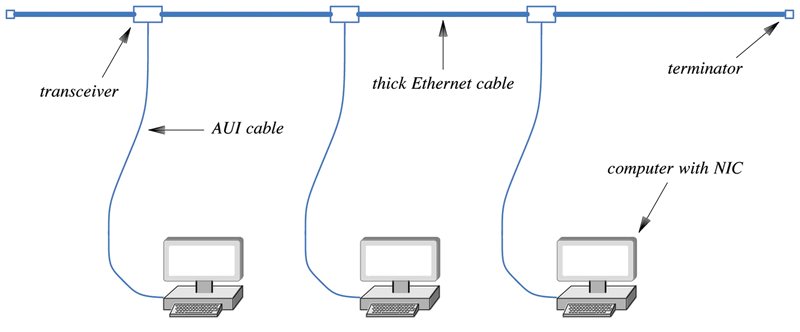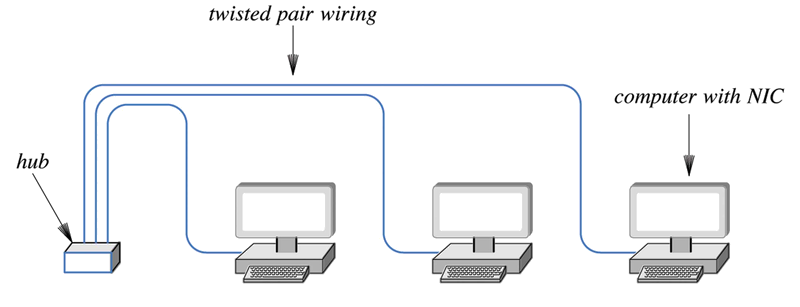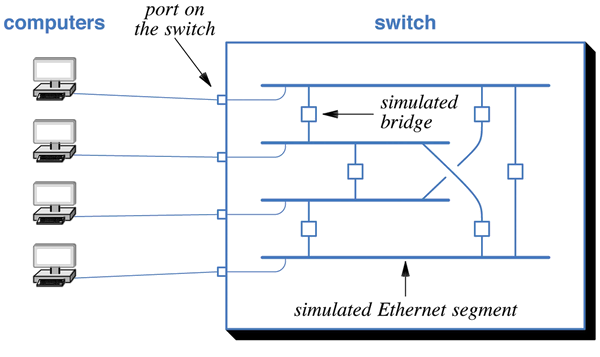Chapter 15, plus switching material from the first part of Chapter 17.
- Frame Format
- Original format (left) is very simple.
- IEEE expanded format (right) has not been widely adopted;
most installations use the classic.
- When the type is >= 1500, it really is a type and the frame is classic.
- Otherwise, the LLC/SNAP is present
- The LLC holds source and destination type codes.
- If it contains a special value, the OUI and type are present, presumably to allow organizations to define their own types.


- History
- Original Ethernet.
- “Thicknet,”, formally 10-Base-5. 10Mbps, 500m segments.

- Bus architecture. Broadcast, CSMA/CD.
- Thick coax, usually in the ceiling.
- Stations connected by a drop cable called a “Attachment Unit Interface” (AUI) cable.
- AUI cable connects to the main one using a clamp that pierces the insulation to connect the cable.
- Terminator is a resister that absorbs signals which reach it. Keeps them from bouncing back through.
- “Thicknet,”, formally 10-Base-5. 10Mbps, 500m segments.
- Thinnnet.
- “Thicknet,” formally 10-Base-2. 10Mbps, 200m (actually 185)
segments.

- Similar bus architecture, broadcast, CSMA/CD.
- Thin coax, screw-in connection at each computer.
- Similar terminator required.
- “Thicknet,” formally 10-Base-2. 10Mbps, 200m (actually 185)
segments.
- Twisted pair (current).
- 10-Base-T. 10Mbps, later 100-Base-T and now higher.
segments.

- Each computer connected to a hub.
- Wiring is twisted pair instead of coax.
- The hub is electrically a bus; still CSMA/CD. Hubs are later replaced with switches (next topic).
- The cables have something like eight wires in them, so I'm not quite sure they're “pairs,” but indeed twisted.
- Originally, different cables were wired differently to connect hubs to computers, and hubs to hubs.
- Most equipment now will automatically figure out what's up, and either cable connection can be used in either circumstance.
- 10-Base-T. 10Mbps, later 100-Base-T and now higher.
segments.
- Original Ethernet.
- Switching.
- Building a larger network

- Simple Bridge.
- Hubs are broadcast media, and a simple Bridge is a repeater.
- If computer B sends a message, it is broadcast to A, C and the Bridge.
- The bridge sends it to Hub 2, which broadcasts it to X, Y and Z.
- But this not very efficient if the message is meant for C; all the forwarding an broadcast on Hub 2 is wasted.
- Leaning Bridges.
- When a packet is forwarded, record which side it came from.
- When a packet is received, see if we know where its destination is.
- Don't forward it if we know the destination is the same side it came from.
- After the learning bridge has been running a while, it will no longer forward packets unnecessarily
- Switches
- A switch looks like a hub, and is connected in the same way.

- Conceptually, each computer is connected through a learning bridge.
- Permits higher bandwidth than a hub: multiple independent conversations.
- Available in many sizes.
- A switch looks like a hub, and is connected in the same way.
- Building a larger network